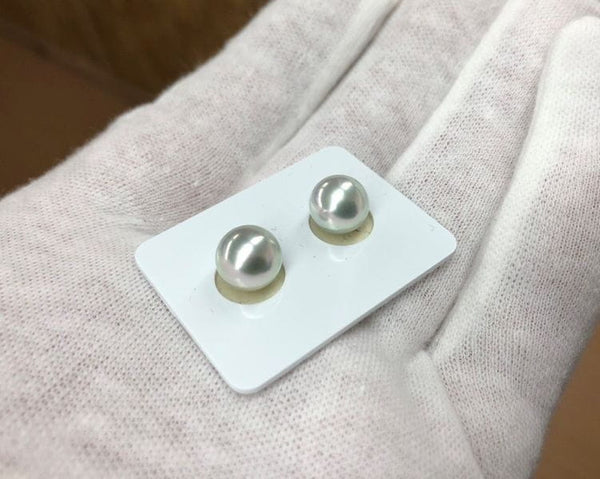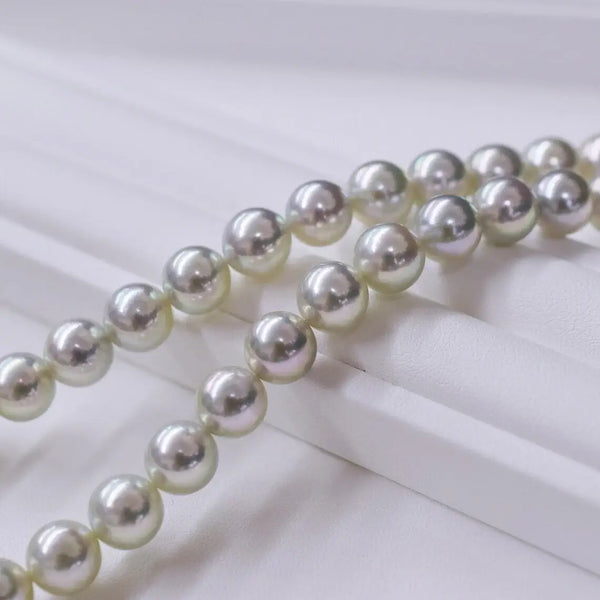
Akoya pearls have always been admired for their lustrous beauty and classic white color. However, there is a hidden treasure among these pearls that has captivated the hearts of many: the mesmerizing blue Akoya pearls. In this blog post, we will delve into the enchanting world of blue Akoya pearls and explore how and why they come to life with their unique hues.
The process of cultivating pearls is an intricate art that requires meticulous attention to detail. During the grafting process, technicians carefully insert a nucleus along with a tiny piece of a mantle tissue into Akoya oyster, initiating the pearl formation. However, when it comes to blue Akoya pearls, a fascinating phenomenon occurs due to a technical error during grafting.
While grafting the nucleus, the delicate gonad of the Pinctada fukata martensii oyster is incised, and the nucleus, along with a tiny piece of donor mantle tissue, is inserted. This tissue, which contains epithelial cells, acts as a catalyst for pearl development. When a technician or a farmer selects the donor shells, one of the biggest roles in selection plays the mother-of-pearl colors. The more colorful they are, or the whiter they are in case of Akoya, the more desirable they are as tissue donors. However, the color of the donor mantle tissue plays a minimal role in the creation of BLUE Akoya pearls.
When the nucleus is inserted incorrectly, in the wrong time of mollusk life cycle, or too traumatically, the mollusk reacts by releasing an organic substance—an inherent anesthetic. This substance not only helps the mollusk cope with the trauma but also significantly influences the color formation of the pearl. It surpasses the impact of the foreign epithelial cells that color the aragonite layers, resulting in the birth of stunning blue pearls.
The organic substance, usually dark in color, interacts with the translucent layers of crystalline nacre that form the pearl. Through this intricate arrangement, what appears as black or brown to the naked eye transforms into a mesmerizing shade of blue. The delicate dance between the organic substance and the layers of nacre gives blue Akoya pearls their unique allure.
Fan Fact: More often than not blue Akoya pearls come out in a baroque shape. More often than not blue Akoya pearls grow larger than white Akoya.

Blue Akoya pearls, both light and dark shades, have been a part of Akoya pearl cultivation since the beginning of more than a hundred years ago. However, due to the focus on producing exceptional white pearls, the deliberate cultivation of blue Akoya pearls remains rare. Their discovery is still a matter of chance, making them even more coveted among pearl enthusiasts.

In the past, blue pearls were often overlooked or discarded, as they were not considered "ideal" for use in jewelry making. But times have changed, and today, there is a growing appreciation for the natural colors of Akoya pearls. Blue, silver, gold, and pistachio shades now proudly stand alongside the traditional white and cream, creating a diverse palette of Akoya beauty.
The journey of blue Akoya pearls is one of nature's delightful surprises. From a technical error during grafting to the release of an unsightly organic substance, these pearls emerge as stunning symbols of uniqueness and rarity.
The increasing popularity and recognition of blue Akoya pearls signify a shift in perspectives, allowing these captivating gems to shine alongside their white counterparts.

As you admire the exquisite blue Akoya pearls, remember the extraordinary story behind their creation, and cherish the beauty that nature graciously bestows upon us.

